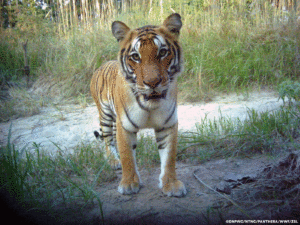 Earlier this year we shared a blog from the ZSL in-country Nepal team about how they count tigers in Nepal, ahead of the nation-wide Nepal tiger census 2018 results being announced.
Earlier this year we shared a blog from the ZSL in-country Nepal team about how they count tigers in Nepal, ahead of the nation-wide Nepal tiger census 2018 results being announced.
The National Tiger and Prey Base Monitoring Survey, developed by the Government of Nepal, and supported by ZSL and other NGOs (Panthera, National Trust for Nature Conservation, WWF) through an IUCN-KFW funded project have just officially announced its findings.
Results of the Nepal Tiger Census 2018
Nepal’s last nationwide survey in 2013 documented ~198 tigers living across 5 protected areas, with the Parsa region (not then elevated to National Park status) home to ~7 wild tigers.
The data, analysed and released by the Ecology Section of Nepal’s Department of National Parks and Wildlife Conservation (DNWPC), has revealed that Nepal is now home to 235 tigers. A 19% increase nationally compared to numbers published in 2013.
WildCats grants specifically support work in Parsa National Park (PNP, formerly Parsa Wildlife Reserve), where the last regional census in 2016 showed 45% increase in tigers. This regional success has consistently improved since 2014, when Panthera & ZSL collaborated to monitor tigers and their prey using camera traps. A programme of intensive training for effective law enforcement using SMART (Spatial Monitoring and Reporting Tool), a computer-based platform that improves the effectiveness of wildlife patrols was also established. You can learn more about the project and read reports dating back to 2015 on our project pages.
The team at WWF-Nepal created this 1-minute short film to show just how much hard work went into this work.
The future
Nepal’s recovery of wild tigers numbers is a roaring success thanks to the collaborative attitude and tremendous commitment of its Government. It is further evidence that wild tigers will thrive given adequate space, prey and protection.
Nepal’s Director General of the Department of National Parks and Wildlife Conservation Krishna Prasad Acharya said: ‘The tiger population in Parsa Wildlife Reserve has significantly increased since the last census, this is fantastic news for tigers and it demonstrates that Nepal’s dedicated conservation efforts are delivering clear results. Nepal has committed to doubling its tiger population by 2022 and encouraging results like these show that we are on track to achieve that.”
Help us to share more happy news stories like this; donate today: conservewildcats.org/donate

